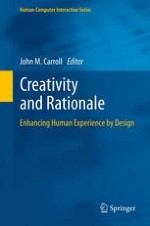2013 | OriginalPaper | Chapter
20. Collaborative Design Rationale and Social Creativity in Cultures of Participation
Authors : Gerhard Fischer, Frank Shipman
Published in: Creativity and Rationale
Publisher: Springer London
Activate our intelligent search to find suitable subject content or patents.
Select sections of text to find matching patents with Artificial Intelligence. powered by
Select sections of text to find additional relevant content using AI-assisted search. powered by
